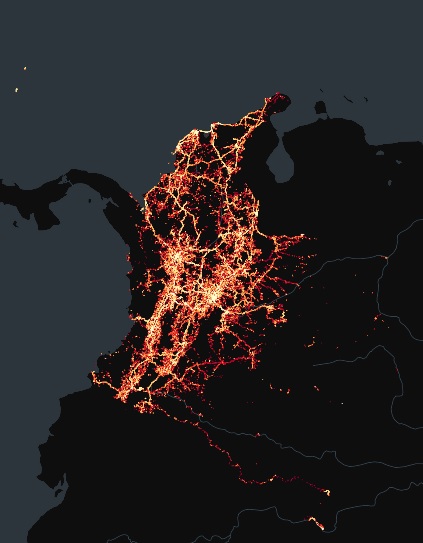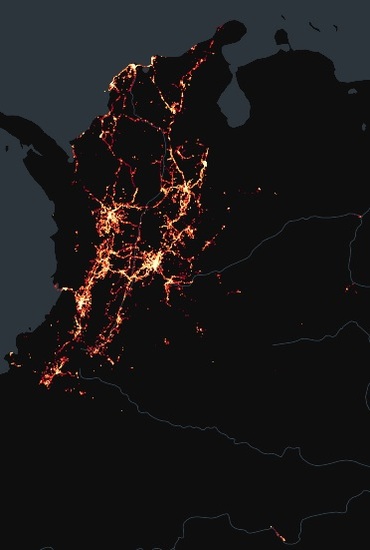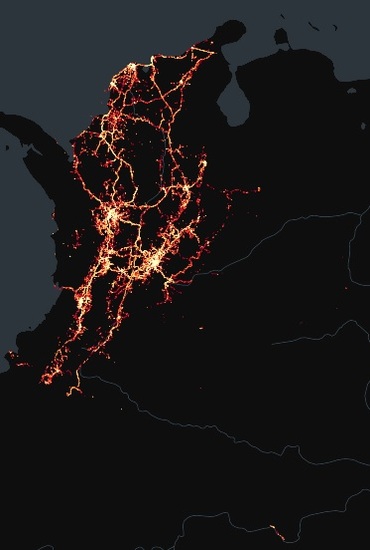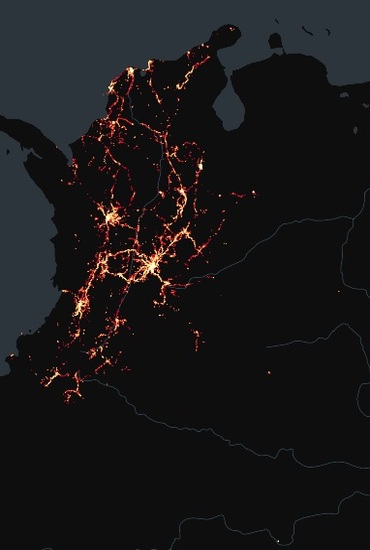Introduction
The Colombian mobile market comprises several operators, of which four have their own networks with nation-wide coverage: Claro, Movistar, Tigo and WOM. Thus, the network situation for these MNOs acts as a trustworthy barometer of the network situation in the country. A deep knowledge of the real performance and QoE of the network helps MNOs and end users make informed decisions, for the first ones for a better network deployment and optimization and for the seconds to choose the MNO that better fulfill their needs.
The objective of this report is to provide a summary of the network situation in Colombia for these four MNOs.
This report provides a quick overview of the network situation based on the following KPIs:
- Disconnection time: daily average minutes that the users from a MNO have had only emergency coverage or no coverage.
- 4G and 5G time: percentage of time that the users from a MNO have had 4G and, if available, 5G coverage (including 5G NSA and 5G SA).
- Area covered by each operator: percentage of area with covered coverage in the country in relation to the operator with the greatest coverage, both urban and non-urban.
- 5G penetration and usage: percentage of users that have 5G connectivity, percentage of time in 5G and percentage of active usage of 5G.
- Network status in the Common Coverage Area: an analysis of the network status, based on the signal strength and the signal quality, for the areas where all MNOs provide coverage.
- Call type: percentage of use of each call type by operator. This shows which technologies each of their customers primarily use.
- Mobile network latency: percentage of customers on different latency ranks. The ranks are selected according to several performance thresholds.
Summary
The Colombian telecommunications market is controlled by four operators with their own networks that together hold almost 93.57% of the market: Claro, Movistar, Tigo and WOM.
In this competition to increase its customer base, Claro is the number 1 operator in Colombia with 45.17% of the market. Further away is Movistar with 23.58% of the market, Tigo with 17.02% and WOM with 7.8%.
The network performance of each operator differs from the another. We will analyze the performance of each of them:
If we take into account the disconnection time, Tigo is the operator that remains without coverage for the least amount of time.
Claro is the operator that covers the most territory in Colombia, both in urban and non-urban areas.
Tigo is the operator that offers 4G coverage to its users the longest, with 92% of the time, while Movistar and Tigo are the one that offers the best quality of 4G coverage, both in area and in measurements.
If we look at the types of calls, Tigo is the operator in which users use VoLTE the most in their calls (92%).
Finally, regarding latency, in general terms, WOM is the best operator with 91% of its measurements being rated as at least good latency (lower than 100ms).
The main key figures are the following:
- The four main operators (Claro, Movistar, Tigo, WOM) in Colombia provide 4G coverage to their customers at least 83% of the time.
- 5G is still in an early phase, and operators have very few 5G users. The MNO with the most 5G customers is currently Claro with 5%.
- Movistar and Tigo are the operators that offers the best quality of 4G coverage, both in area and measurements.
- VoLTE calls are especially relevant for the four operators, accounting for at least 64% of total calls.
- At least 85% of measurements from all operators have good enough latency (lower than 100 ms) for a decent experience in all possible types of use.
Methodology

In the following pages an in-depth description of each analyzed KPI can be found, including the methodology and rationale behind them.
At a more general level, the following paragraph describes the data collection methodology.
Weplan Analytics collects crowdsourced data from more than 200 million devices in 31 countries. For this analysis, 700 million measurements collected between August and October 2024 were used.
The following map shows the density of measurements taken throughout Colombia by Weplan Analytics.
As the four aforementioned MNOs serve their networks to other parties (such as VMNOs, due to roaming agreements or as part of emergency coverage) they have been filtered by the network provider reported in the SIM card.
More details about the methodology can be found here.
Connectivity
Connectivity: Daily disconnection time
The following chart shows the disconnection average time in minutes each customer experiences from each MNO in a day.
Disconnection time includes moments when a customer has no coverage at all (such as underground parkings, inside elevators, so far away from an antenna that connection is not possible...) or moments when a customer has only the possibility to make emergency calls.
This disconnected time may (and, in most cases, will) be discontinuous, and is the average of the daily disconnection time for all users.
Tigo is the operator that has the shortest daily disconnection time with only 12 minutes per day.
Connectivity: 4G and 5G time
As a result of the development of 5G technology, legacy technologies such as the 2G and 3G networks are being turned off with the aim of freeing up electromagnetic spectrum to make room for more modern technologies such as 4G and 5G. This is because the frequencies are limited, so it is necessary to turn off the old ones so that the new technologies can reuse them. Thus, one of the main objectives of operators is to guarantee at least adequate 4G coverage, and for those that already meet this objective, the focus turns to 5G.
Tigo has the best 4G or higher coverage time for its customers, maintaining this coverage 92% of the time.
Percentage of area covered by each carrier
In the following images we can see the sample density for each operator and their coverage footprint:








The larger the area covered, the more extensive the network, and the more difficult it is to maintain consistent service.
Coverage in urban areas will always be more stable than that received in non-urban areas.
We will take as a reference the operator that covers the most area, in this case Claro.
If we look at the coverage areas of each operator, we can see that Tigo covers 55% of the territory compared to Claro, followed by Movistar with 54% and WOM with 25%.
It is also important to highlight that Claro is the operator that covers the most non-urban area of the four operators.
5G penetration and usage
The arrival of 5G to Colombia has been quite late, starting with the auction of frequencies in December 2023, where these were distributed in this way:
- An 80 Mhz block in the 3500 band for Claro.
- An 80 Mhz block in the 3500 band for the temporary union of Movistar and Tigo.
- An 80 Mhz block in the 3500 band for WOM.
- And the last block in the same band, for Telecall, new carrier of Brazilian origin.
The auction includes coverage commitments in municipalities that are home to 54% of the national population, as well as 4G coverage on 34 primary and secondary roads in the country, over 700 km. Among the obligations are also contemplated connecting the country's educational institutions.
After this auction, the switching on of 5G networks began in February 2024, with Claro, Movistar and Tigo being the first operators to switch on their networks.
The fact that it has initially been activated only in some cities, together with the fact that some operators only have 5G available in postpaid plans or that some operators have not yet turned on their networks (WOM, Telecall) has meant that the adoption of 5G in Colombia is in a very early phase, with hardly any 5G customers.
Percentage of 5G users by carrier
Claro is the operator with the most 5G clients, with 5% of 5G clients, followed by Movistar and Tigo tied with 1% of 5G clients. WOM has not yet deployed its 5G network.
Percentage of time spent under 5G coverage for 5G customers by carrier
If we look at the time in which each user has 5G coverage available, Claro is the winner with 17% of the time with 5G coverage available. It is followed by Tigo with 5% and Movistar with 2%.
Percentage of 5G usage time for 5G users
When a user connects to the 5G network, they can do so under a Stand Alone (5G SA, pure 5G) or Non Stand Alone (5G NSA, 5G supported by the LTE network) connection.
When a user connects to the 5G NSA network, they can use only the LTE part (although they still see on their terminal that it is connected to 5G) or also the 5G part. Connecting in one way or another is mainly due to the use and capacity of the network, with the 5G network being prioritized for intensive data uses (e.g. streaming, video calls, video games, etc.) and leaving the 4G network for less intensive uses (e.g. messaging, low consumption web browsing, etc.).
The following chart shows the percentage of time that users are connected to a 5G network and are also using 5G technology.
If we emphasize the time that each user uses the available 5G, Claro users use the 5G network 12% of the time, followed by Movistar and Tigo tied with 2%.
4G and 5G network status
There are two main network performance indicators used to address the network status: signal strength and signal quality. Each technology has its own measurements, but two great categories can be established:
- Very Good: the network performance for all usages should be excellent.
- Good: the network performance for all usages may present occasional difficulties but is good overall.
- Fair: most network network-dependent usages (such as calls or data usage) will have at least a decent performance.
- Degraded: network usage may be unstable and unreliable but allows for basic usage such as calls with acceptable quality and very slow data transfer rate.
- Very Degraded: apart from emergency calls network usage is nearly impossible.
There are two ways to analyze these categories: by percentage of covered area or by percentage of measurements.
Most measurements take place in urban areas, where coverage is better.
However, it is important to note that in most countries the majority of the territory is not urban, so the percentage of area with a problematic network situation may be different from the percentage of measurements with a problematic network situation.
In general, all operators offer decent coverage in the common coverage area in Colombia.
Tigo is the operator with the best results with 89% of the area rated as at least fair. Following are Movistar with 88%, Claro with 73% and WOM with 61%.
If you look at measurements instead of area, the general situation is very similar.
Movistar and Tigo are the operators with the best results tied with 79% of the measurements classified as, at least, fair. It is followed by Claro with 62% and WOM with 61%.
Call type percentage
Although 2G and 3G technologies allow the use of data, the development of 4G and 5G has left these technologies largely relegated to use in phone calls.
However, not all customers can benefit from VoLTE calls, since in order for them to be used, the following conditions must be met:
- Your MNO must provide 4G and VoLTE.
- They must have a phone capable of making VoLTE calls and a mobile plan that includes VoLTE.
- Your phone must be approved by the MNO and the manufacturer to make VoLTE calls.
The last condition means that a customer, without changing their phone, can have VoLTE with one operator, but not have it with another. When a 4G connected customer without VoLTE capability (for any reason) attempts to make a call, a handover process to the 2G or 3G network occurs.
This process, depending on the method applied, is called CSFB (the most common) or SRVCC. In addition, there is also VoWiFi (Voice over Wi-Fi) technology, which is used when a Wi-Fi network is available.
VoLTE technology is the most used by Tigo customers, with 92% of total calls using this technology. It is followed by Claro with 82%, Movistar with 77% and WOM with 64%.
Latency status
Latency is the measurement of how much time it takes for the information to be transmitted between the user and the network. A lower latency means a faster, and smoother network experience, whereas a higher latency means that the network experience will not be as good, or even unusable. This makes latency a good indicator for user experience. We have divided latency in four main groups:
- Excellent latency: very smooth user experience, even with the most data-intensive usage, such as gaming or 4K streaming.
- Good latency: good user experience, although gaming may not be as fluid and 4K may present occasional problems.
- Degraded latency: mediocre user experience. Gaming and 4K are either uncomfortable or impossible, videochat may present noticeable lag, messaging with multimedia may take a long time to load and loading a web may be slow.
- Bad latency: essentially unusable network. Only the lightest usage, such as sending messages without multimedia works decently.
There are some differences in latency between operators.
WOM has the best latency with 91% of their measurements rated as good or excellent. It is followed by Tigo with 89%, Claro with 88% and Movistar with 85% of measurements classified as, at least, good.

Sent successfully
Email sent with unlock instructions. Please check your inbox
Error sending form
There was an error processing this request. PLease try again later
To read the report please leave us your details:
An email will be sent to your address with a link to unlock it:
The information on this report is provided as of public interest by Weplan Analytics. The information on this report is provided by Weplan Analytics solely for the user's information and it is provided without warranty, guarantee or responsibility of any kind, either expressed or implied. Weplan Analytics and its employees will not be liable for any loss or damages of any nature, either direct or indirect, arising from use of the information provided in this report. Weplan Analytics is the owner of copyright in all material or information found on this report unless otherwise stated. All contents that are published in this report are safeguarded by copyright. This copyright includes the exclusive right to reproduce and distribute the contents, including reprints, translations, photographic reproductions, electronic forms (online or offline) or other reproductions of other similar kinds. Only non-commercial use may be beyond the limitations with prior written consent. Journalists are encouraged to quote information included in Weplan Analytics reports and insights as long as clear source attribution is provided. For more information, contact [email protected]

